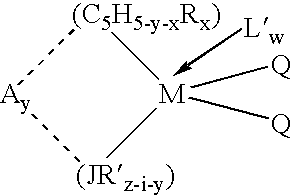Polymerization catalyst systems, their use, their products and articles thereof
a technology of polymerization catalysts and catalyst systems, applied in the field of catalyst systems and their use in olefin polymerization, can solve the problems of poor overall activity and inferiority of polymerization catalysts
- Summary
- Abstract
- Description
- Claims
- Application Information
AI Technical Summary
Benefits of technology
Problems solved by technology
Method used
Image
Examples
example 1
Preparation of Catalyst
[0080]A solution of methylalumoxane and metallocene was formed by adding 11 cm3 of 30 wt-% MAO solution in toluene onto 0.202 g of bis(n-propylcyclopentadienyl) hafnium dichloride in a vial. 40 cm3 of fresh toluene was added, and the mixture stirred for 1 hour at 25° C. This pre-mixed solution of the MAO and the metallocene was then added onto 10 g of Davison 948 silica dried to 600° C. The resulting slurry was stirred for 1.5 hours at 25° C. The final catalyst was then dried to free-flowing powder under vacuum at 65° C.
[0081]A sample of the dry catalyst formed in the above Example 1 was then used in a polymerization process of ethylene / 1-butene in a 2-liter semi-batch gas-phase reactor at 85° C. The pressure in the reactor, about 155 psig (1069 kpag), was held constant by continuously feeding 5 mol-% 1-butene in ethylene to compensate for any pressure changes due to polymerization. After 1 h (hour), the polymer formed was separated from the seed...
example 2
Preparation of Catalyst
[0082]A solution of methylalumoxane and metallocene was formed by adding 66.5 cm3 of 30 wt-% MAO solution in toluene onto 1.21 g of bis(n-propylcyclopentadienyl) hafnium dichloride in a vial. 50 cm3 of fresh toluene was added, and the mixture stirred for 1.5 hours at 25° C. This pre-mixed solution of the MAO and the metallocene was then added onto 60 g of Davison 948 silica dried to 600° C. The resulting slurry was stirred for 1.5 hours at 25° C. Then a solution of 0.41 g of N,N-bis(2-hydroxylethyl) octadecylamine in 50 cm3 toluene was added, and stirring continued for another 30 minutes. The final catalyst was then dried to free-flowing powder under vacuum at 65° C.
[0083]A sample of the dry catalyst formed in Example 2 was then used in a polymerization process of ethylene / 1-butene in a 2-liter semi-batch gas-phase reactor at 85° C. The pressure in the reactor, about 158 psig (1089 kPag), was held constant by continuously feeding 5 mol-% 1-butene...
example 3
Preparation of Catalyst
[0084]Methylalumoxane (MAO) (1155 cm3 of 30 wt-% solution in toluene) was charged into a 2-gallon reaction vessel. 1970 cm3 of fresh toluene was added. Then a solution of 20.2 g of bis(n-propylcyclopentadienyl) hafnium dichloride in 355 cm3 toluene was added. The temperature was maintained at 27° C. and the mixture stirred for 1.5 hour. A 1000 g of a Davison 948 silica dehydrated at 600° C. was charged into a 2-gallon reaction vessel at 27° C. The solution of methylalumoxane and metallocene from above was added onto the silica in two equal portions. Then an additional 250 cm3 toluene was added to the slurry. After 1 hour, a solution of 6.7 g of N,N-bis(2-hydroxylethyl) octadecylamine in 70 cm3 toluene was added and stirring continued for another 20 minutes. The final catalyst was then dried to free-flowing powder at 68° C. under vacuum.
[0085]Samples of the dry catalyst formed in Example 3 each were then used in a polymerization process of ethylen...
PUM
| Property | Measurement | Unit |
|---|---|---|
| temperature | aaaaa | aaaaa |
| temperature | aaaaa | aaaaa |
| temperature | aaaaa | aaaaa |
Abstract
Description
Claims
Application Information
 Login to View More
Login to View More - R&D
- Intellectual Property
- Life Sciences
- Materials
- Tech Scout
- Unparalleled Data Quality
- Higher Quality Content
- 60% Fewer Hallucinations
Browse by: Latest US Patents, China's latest patents, Technical Efficacy Thesaurus, Application Domain, Technology Topic, Popular Technical Reports.
© 2025 PatSnap. All rights reserved.Legal|Privacy policy|Modern Slavery Act Transparency Statement|Sitemap|About US| Contact US: help@patsnap.com

